Abstract
The mechanical properties of left ventricular contraction were described in terms of tension, velocity, length, and time in closed-chest, sedated dogs in which a large aorto-caval fistula had resulted in circulatory congestion, and the results were compared with those in normal dogs. Instantaneous contractile element velocity was calculated from left ventricular pressure and its first derivative during isovolumic left ventricular contractions produced by sudden balloon occlusion of the ascending aorta during diastole. A range of ventricular end-diastolic volumes was induced and heart rate was controlled at 150 beats/min. Wall tension (stress) was derived from ventricular pressure and volume, the latter being obtained from the pressure-volume relation of the passive ventricle. Extrapolated velocity at zero tension, Vmax, averaged 3.0 circ/sec in the normal dogs and 2.9 circ/sec in the seven dogs with an aorto-caval fistula and fluid retention; in only one of these seven animals was Vmax below the lower limit of normal of 2.7 circ/sec. Isovolumic tension (Po) in dogs with aorto-caval fistulas tended to be slightly greater than normal at low ventricular filling pressures, and there was no difference in Po between the two groups of animals at high ventricular filling pressures. Time to peak pressure averaged 151 ± 6 (SE) msec (normal 139 ± 3). Left ventricular weight averaged 6.32 ± 0.23 g/kg of initial body weight (normal 5.25 ± 0.56 g/kg) (P < 0.001), which reflected moderate ventricular hypertrophy, and ventricular internal volume at a given filling pressure was increased proportionally. Therefore, the ventricular contractile state usually was normal in the dog with a large aorto-caval fistula, and it is proposed that mechanisms for fluid retention that results in circulatory congestion were activated because of the large hemodynamic burden despite normal myocardial contractile properties.
Full text
PDF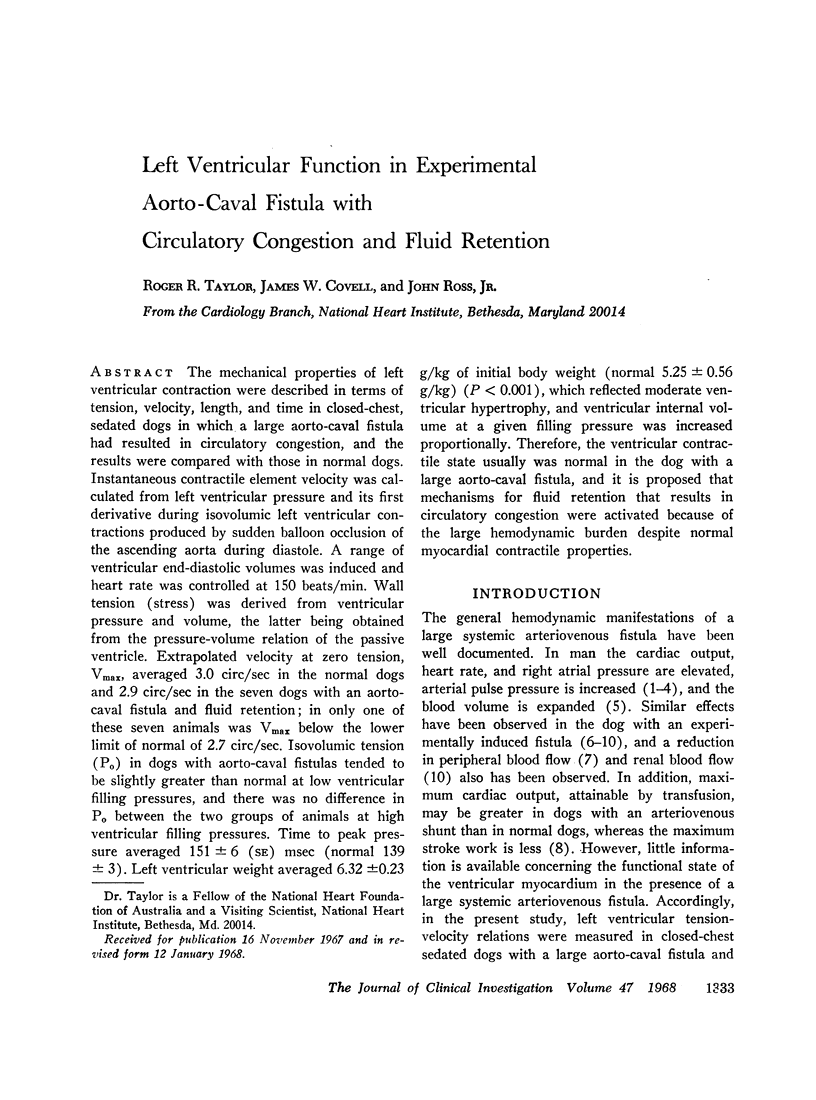
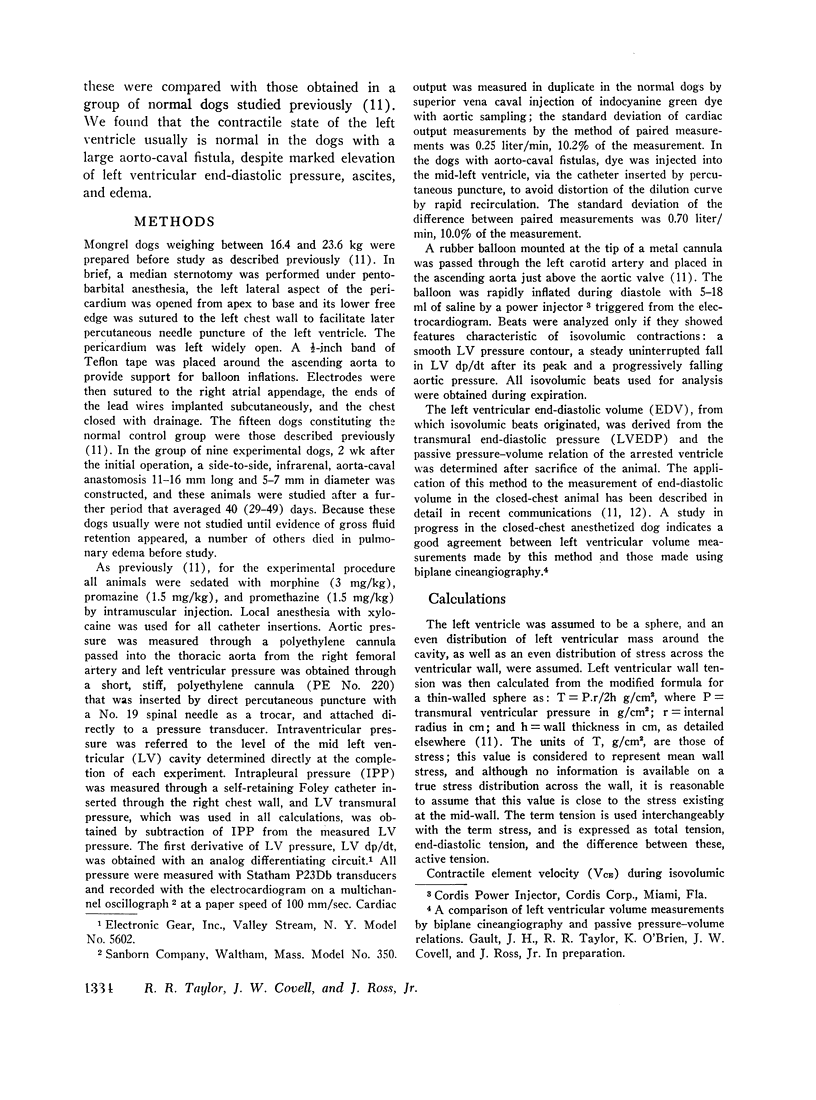
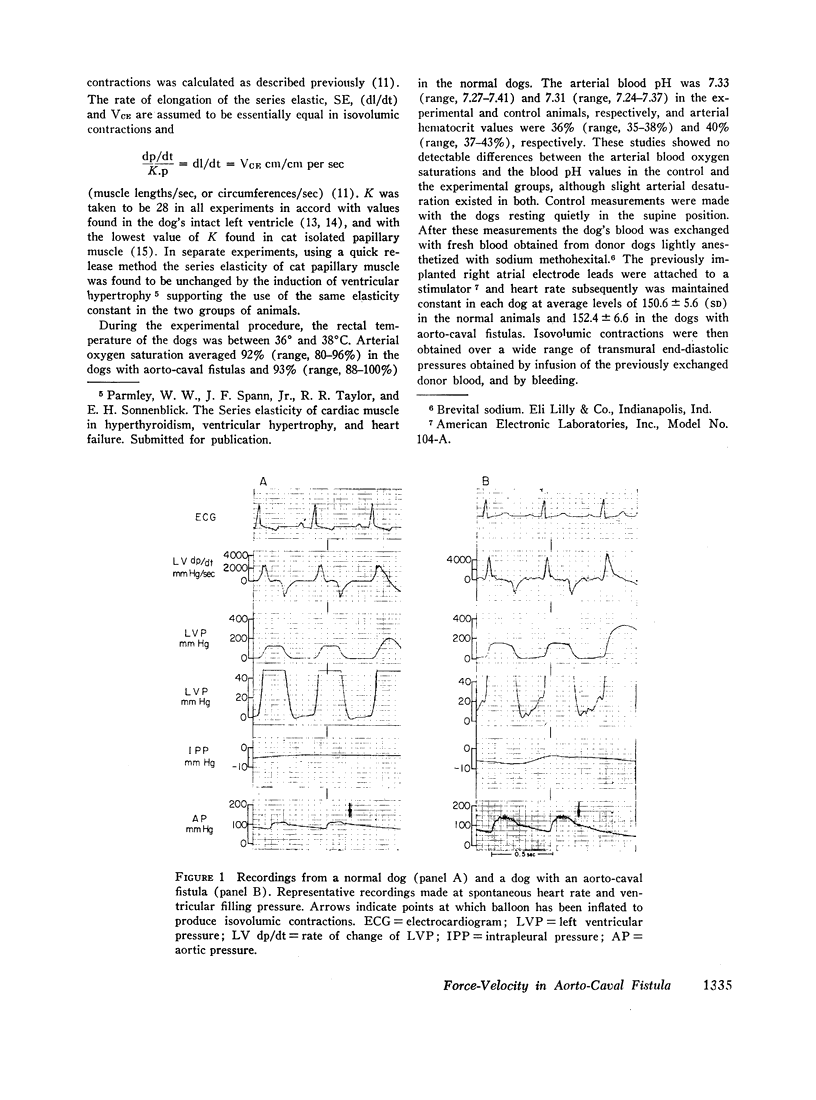
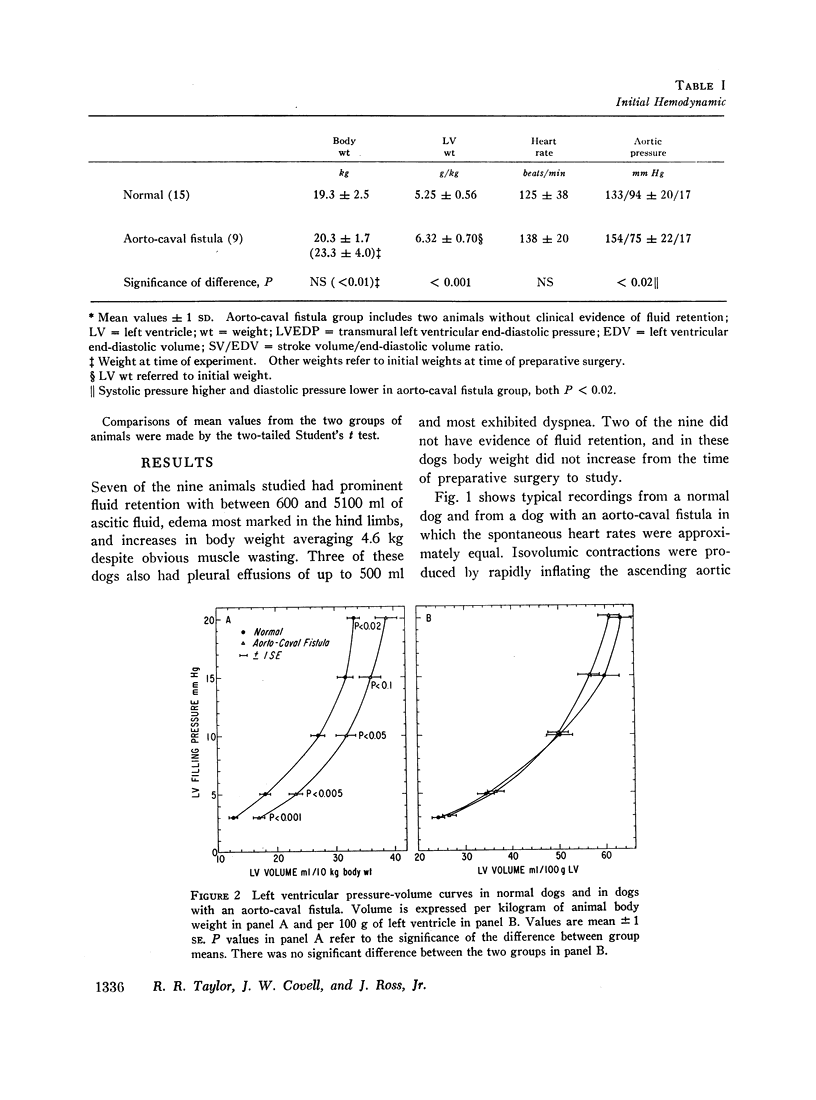
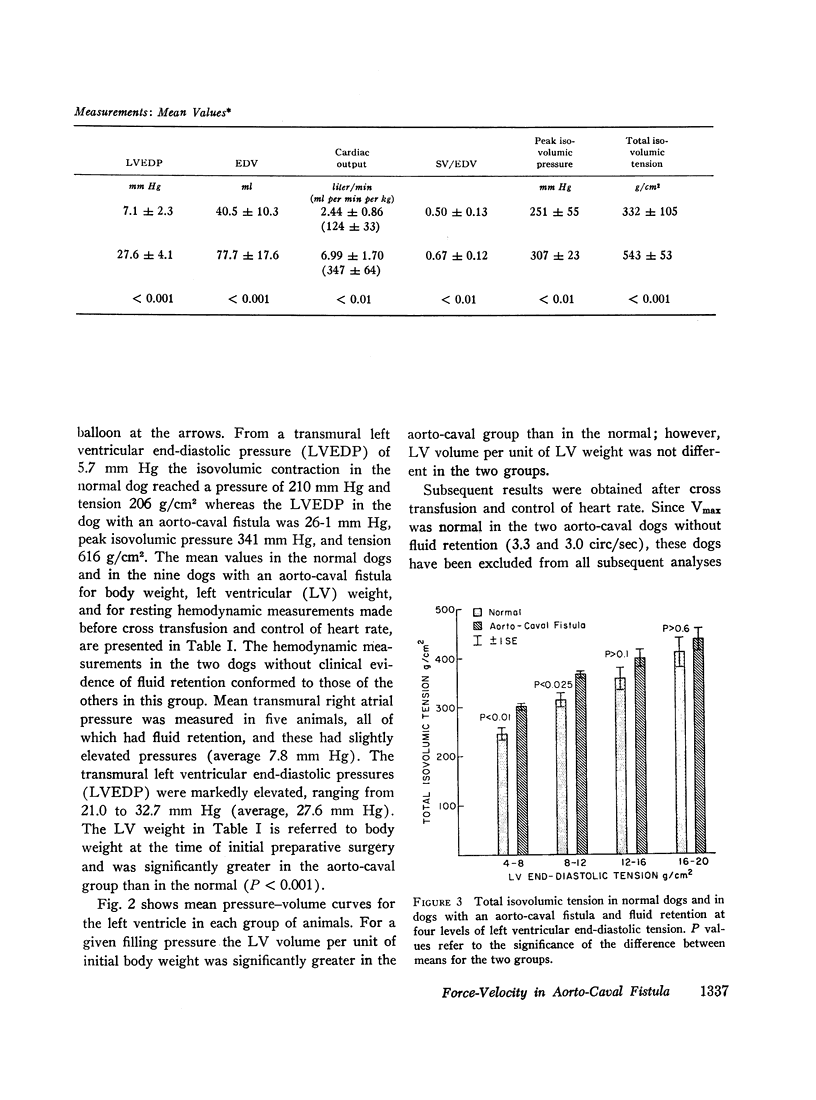
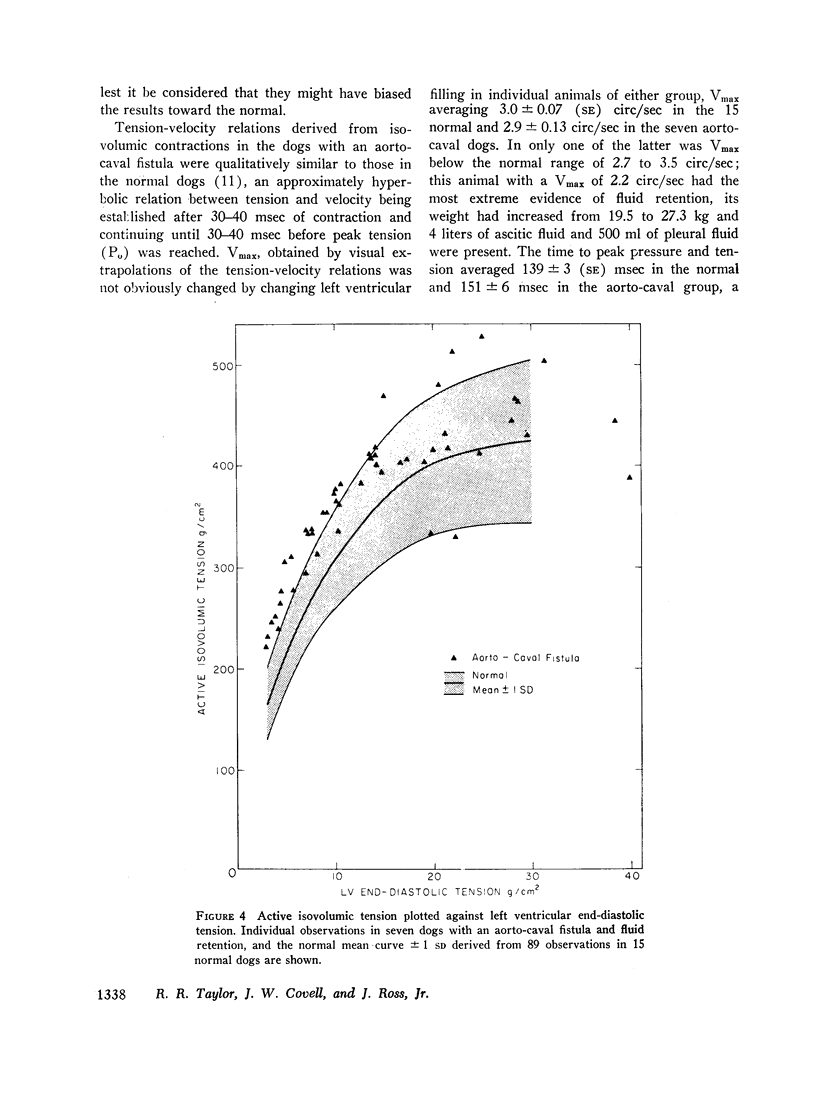


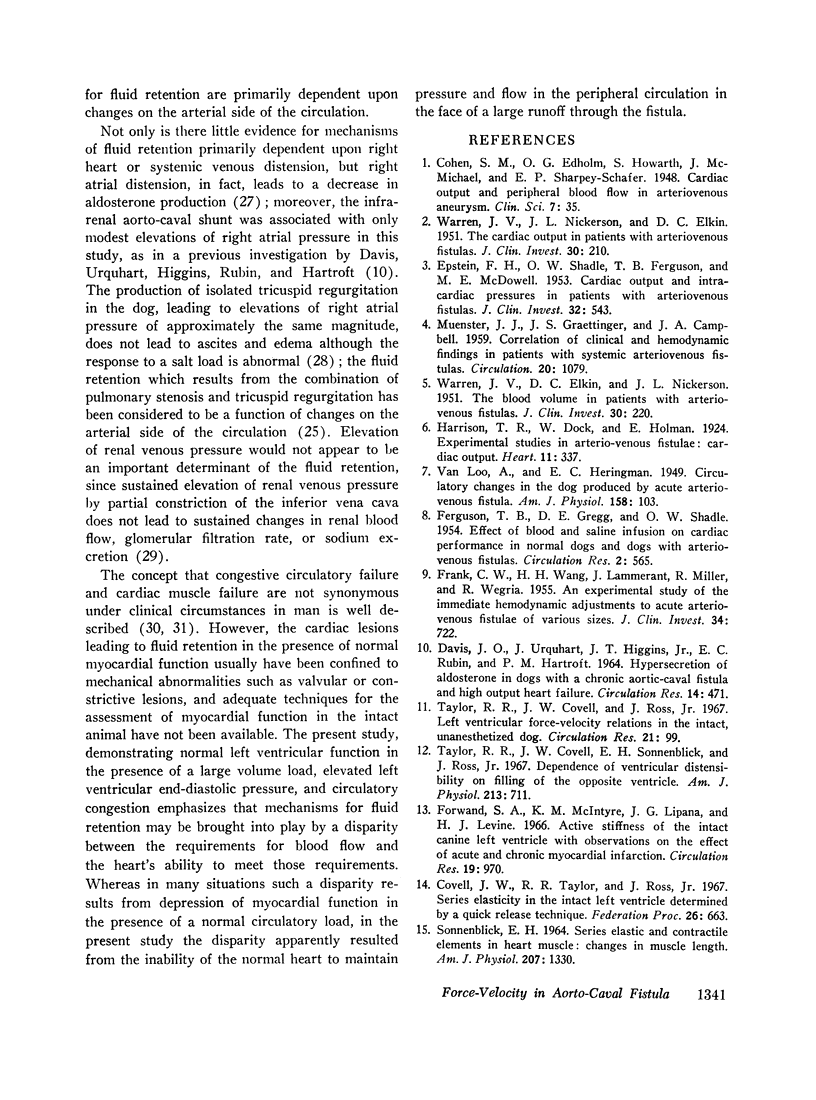
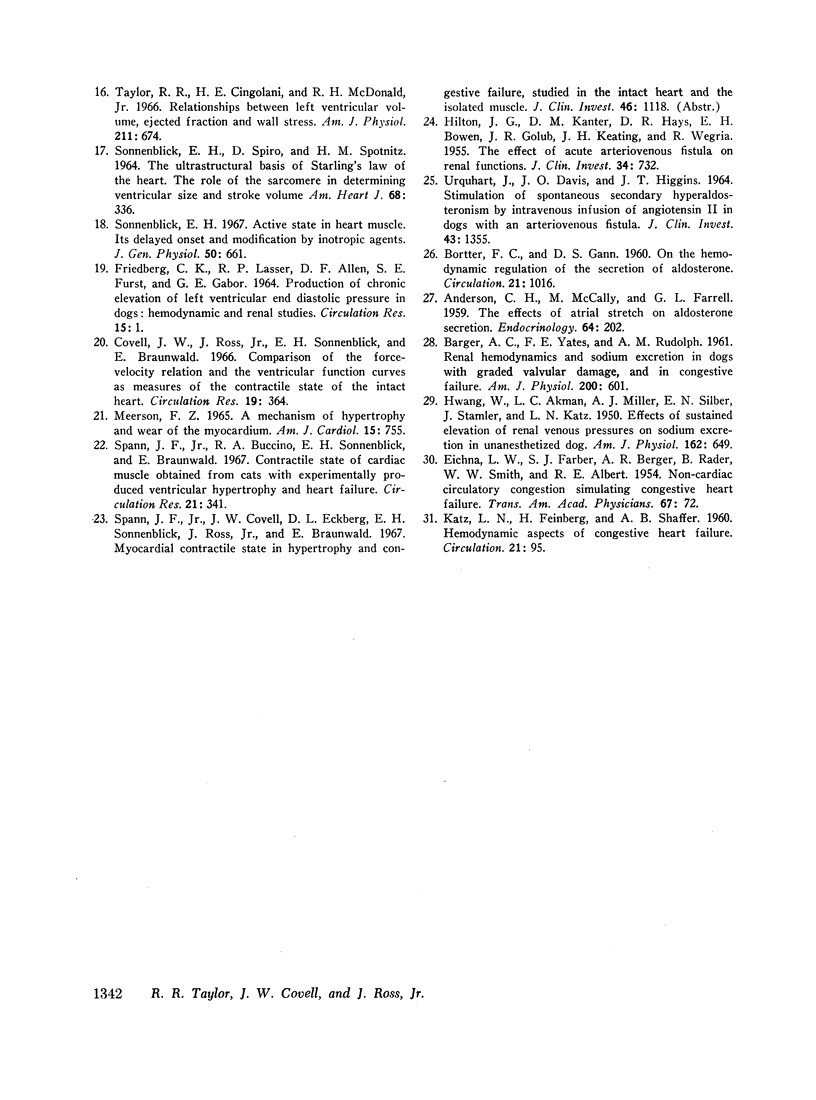
Images in this article
Selected References
These references are in PubMed. This may not be the complete list of references from this article.
- ANDERSON C. H., McCALLY M., FARRELL G. L. The effects of atrial stretch on aldosterone secretion. Endocrinology. 1959 Feb;64(2):202–207. doi: 10.1210/endo-64-2-202. [DOI] [PubMed] [Google Scholar]
- BARGER A. C., YATES F. E., RUDOLPH A. M. Renal hemodynamics and sodium excretion in dogs with graded valvular damage, and in congestive failure. Am J Physiol. 1961 Mar;200:601–608. doi: 10.1152/ajplegacy.1961.200.3.601. [DOI] [PubMed] [Google Scholar]
- BARTTER F. C., GANN D. S. On the hemodynamic regulation of the secretion of aldosterone. Circulation. 1960 May;21:1016–1023. doi: 10.1161/01.cir.21.5.1016. [DOI] [PubMed] [Google Scholar]
- Covell J. W., Ross J., Jr, Sonnenblick E. H., Braunwald E. Comparison of the force-velocity relation and the ventricular function curve as measures of the contractile state of the intact heart. Circ Res. 1966 Aug;19(2):364–372. doi: 10.1161/01.res.19.2.364. [DOI] [PubMed] [Google Scholar]
- DAVIS J. O., URQUHART J., HIGGINS J. T., Jr, RUBIN E. C., HARTROFT P. M. HYPERSECRETION OF ALDOSTERONE IN DOGS WITH A CHRONIC AORTIC-CAVAL FISTULA AND HIGH OUTPUT HEART FAILURE. Circ Res. 1964 Jun;14:471–485. doi: 10.1161/01.res.14.6.471. [DOI] [PubMed] [Google Scholar]
- EICHNA L. W., FARBER S. J., BERGER A. R., RADER B., SMITH W. W., ALBERT R. E. Non-cardiac circulatory congestion simulating congestive heart failure. Trans Assoc Am Physicians. 1954;67:72–85. [PubMed] [Google Scholar]
- EPSTEIN F. H., SHADLE O. W., FERGUSON T. B., MCDOWELL M. E. Cardiac output and intracardiac pressures in patients with arteriovenous fistulas. J Clin Invest. 1953 Jun;32(6):543–547. doi: 10.1172/JCI102770. [DOI] [PMC free article] [PubMed] [Google Scholar]
- FERGUSON T. B., GREGG D. E., SHADLE O. W. Effect of blood and saline infusion on cardiac performance in normal dogs and dogs with arteriovenous fistulas. Circ Res. 1954 Nov;2(6):565–572. doi: 10.1161/01.res.2.6.565. [DOI] [PubMed] [Google Scholar]
- FRANK C. W., WANG H. H., LAMMERANT J., MILLER R., WEGRIA R. An experimental study of the immediate hemodynamic adjustments to acute arteriovenous fistulae of various sizes. J Clin Invest. 1955 May;34(5):722–731. doi: 10.1172/JCI103125. [DOI] [PMC free article] [PubMed] [Google Scholar]
- FRIEDBERG C. K., LASSER R. P., ALLEN D. F., FURST S. E., GABOR G. E. PRODUCTION OF CHRONIC ELEVATION OF LEFT VENTRICULAR END DIASTOLIC PRESSURE IN DOGS: HEMODYNAMIC AND RENAL STUDIES. Circ Res. 1964 Jul;15:1–10. doi: 10.1161/01.res.15.1.1. [DOI] [PubMed] [Google Scholar]
- Forwand S. A., McIntyre K. M., Lipana J. G., Levine H. J. Active stiffness of the intact canine left ventricle. With observations on the effect of acute and chronic myocardial infarction. Circ Res. 1966 Nov;19(5):970–979. doi: 10.1161/01.res.19.5.970. [DOI] [PubMed] [Google Scholar]
- HILTON J. G., KANTER D. M., HAYS D. R., BOWEN E. H., GOLUB J. R., KEATING J. H., WEGRIA R. The effect of acute arteriovenous fistula on renal functions. J Clin Invest. 1955 May;34(5):732–736. doi: 10.1172/JCI103126. [DOI] [PMC free article] [PubMed] [Google Scholar]
- HWANG W., AKMAN L. C., MILLER A. J., SILBER E. N., STAMLER J., KATZ L. N. Effects of sustained elevation of renal venous pressure on sodium excretion in unanesthetized dog. Am J Physiol. 1950 Sep;162(3):649–654. doi: 10.1152/ajplegacy.1950.162.3.649. [DOI] [PubMed] [Google Scholar]
- KATZ L. N., FEINBERG H., SHAFFER A. B. Hemodynamic aspects of congestive heart failure. Circulation. 1960 Jan;21:95–111. doi: 10.1161/01.cir.21.1.95. [DOI] [PubMed] [Google Scholar]
- MEERSON F. Z. A MECHANISM OF HYPERTROPHY AND WEAR OF THE MYOCARDIUM. Am J Cardiol. 1965 Jun;15:755–760. doi: 10.1016/0002-9149(65)90377-2. [DOI] [PubMed] [Google Scholar]
- MUENSTER J. J., GRAETTINGER J. S., CAMPBELL J. A. Correlation of clinical and hemodynamic findings in patients with systemic arteriovenous fistulas. Circulation. 1959 Dec;20:1079–1086. doi: 10.1161/01.cir.20.6.1079. [DOI] [PubMed] [Google Scholar]
- SONNENBLICK E. H. SERIES ELASTIC AND CONTRACTILE ELEMENTS IN HEART MUSCLE: CHANGES IN MUSCLE LENGTH. Am J Physiol. 1964 Dec;207:1330–1338. doi: 10.1152/ajplegacy.1964.207.6.1330. [DOI] [PubMed] [Google Scholar]
- SONNENBLICK E. H., SPIRO D., SPOTNITZ H. M. THE ULTRASTRUCTURAL BASIS OF STARLING'S LAW OF THE HEART. THE ROLE OF THE SARCOMERE IN DETERMINING VENTRICULAR SIZE AND STROKE VOLUME. Am Heart J. 1964 Sep;68:336–346. doi: 10.1016/0002-8703(64)90301-1. [DOI] [PubMed] [Google Scholar]
- Sonnenblick E. H. Active state in heart muscle. Its delayed onset and modification by inotropic agents. J Gen Physiol. 1967 Jan;50(3):661–676. doi: 10.1085/jgp.50.3.661. [DOI] [PMC free article] [PubMed] [Google Scholar]
- Spann J. F., Jr, Buccino R. A., Sonnenblick E. H., Braunwald E. Contractile state of cardiac muscle obtained from cats with experimentally produced ventricular hypertrophy and heart failure. Circ Res. 1967 Sep;21(3):341–354. doi: 10.1161/01.res.21.3.341. [DOI] [PubMed] [Google Scholar]
- Taylor R. R., Cingolani H. E., McDonald R. H., Jr Relationships between left ventricular volume, ejected fraction, and wall stress. Am J Physiol. 1966 Sep;211(3):674–680. doi: 10.1152/ajplegacy.1966.211.3.674. [DOI] [PubMed] [Google Scholar]
- Taylor R. R., Covell J. W., Sonnenblick E. H., Ross J., Jr Dependence of ventricular distensibility on filling of the opposite ventricle. Am J Physiol. 1967 Sep;213(3):711–718. doi: 10.1152/ajplegacy.1967.213.3.711. [DOI] [PubMed] [Google Scholar]
- Taylor R. R., Ross J., Jr, Covell J. W., Sonnenblick E. H. A quantitative analysis of left ventricular myocardial function in the intact, sedated dog. Circ Res. 1967 Jul;21(1):99–115. doi: 10.1161/01.res.21.1.99. [DOI] [PubMed] [Google Scholar]
- URQUHART J., DAVIS J. O., HIGGINS J. T., Jr SIMULATION OF SPONTANEOUS SECONDARY HYPERALDOSTERONISM BY INTRAVENOUS INFUSION OF ANGIOTENSIN II IN DOGS WITH AN ARTERIOVENOUS FISTULA. J Clin Invest. 1964 Jul;43:1355–1366. doi: 10.1172/JCI105011. [DOI] [PMC free article] [PubMed] [Google Scholar]
- VAN LOO A., HERINGMAN E. C. Circulatory changes in the dog produced by acute arteriovenous fistula. Am J Physiol. 1949 Jul;158(1):103–112. doi: 10.1152/ajplegacy.1949.158.1.103. [DOI] [PubMed] [Google Scholar]
- WARREN J. V., ELKIN D. C., NICKERSON J. L. The blood volume in patients with arteriovenous fistulas. J Clin Invest. 1951 Feb;30(2):220–226. doi: 10.1172/JCI102436. [DOI] [PMC free article] [PubMed] [Google Scholar]
- WARREN J. V., NICKERSON J. L., ELKIN D. C. The cardiac output in patients with arteriovenous fistulas. J Clin Invest. 1951 Feb;30(2):210–214. doi: 10.1172/JCI102434. [DOI] [PMC free article] [PubMed] [Google Scholar]





